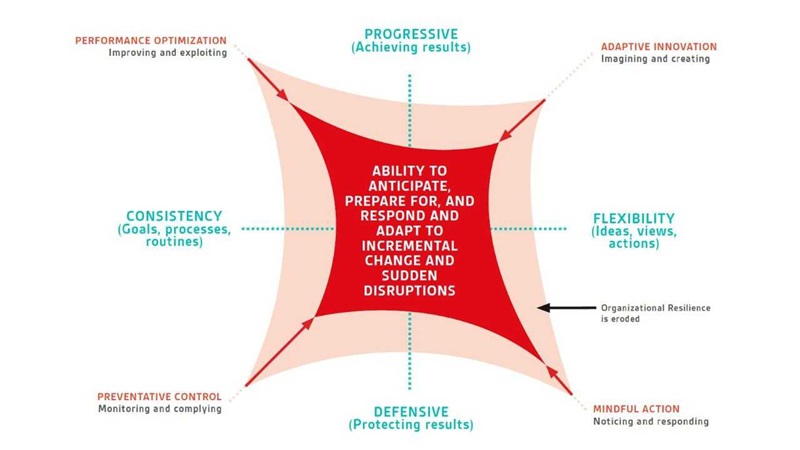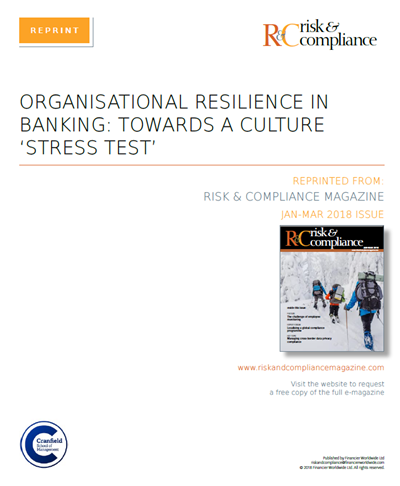In September 2008, the collapse of Lehman Brothers almost brought the financial system to its knees and plunged world economies into turmoil. The after effects are still felt today. Massive taxpayer-financed bail-outs of financial institutions, too big to fail, left economies reeling under increasing debt levels.
Key Facts
-
With a decade’s hindsight, it becomes clear that the financial sector including banks and insurers lacked organisational resilience to withstand the detrimental effects of securitised products the banks developed to yield higher returns in times of low interest rates.
-
A recent collaborative research project between Cranfield School of Management and the British Standards Institute identified two core drivers of organisational resilience: organisations must have a defensive mindset to stop negative things from happening and to protect results. Yet, to ensure long term survival in a competitive market place they must also have a progressive mindset, thereby generating positive results. There are also two ways to achieve organisational resilience: organisations need to be consistent by standardising policies, processes and behaviours. Yet they must also be flexible by fostering diverse ideas and perspectives, creative problem solving and innovation to cope with and thrive in a dynamic environment. These four aspects of organisation resilience were synthesised into a holistic framework with four organisational resilience archetypes.

Adapted from Denyer, D. 2017. “Organizational Resilience: A Summary of Academic Evidence, Business Insights and New Thinking.” BSI and Cranfield School of Management.
- Preventative control (defensive + consistent) – organizational resilience is achieved by means of controlling risk, building redundancy (spare capacity) and ensuring back-up systems to protect the organization from threats.People, from this perspective, are thought to be unreliable so there is also a strong focus on standardized procedures, compliance and regulation.
- Mindful action (defensive + flexible) – competent people also make a positive contribution to organizational resilience by noticing problems, reading unfamiliar or challenging situations, reacting rapidly to problems and avoiding trapping or mitigating threats.
- Performance optimisation (progressive + consistent): organizations will not be resilient unless they continually improve by refining and extending existing competencies, generating efficiency gain, enhancing existing ways of working and exploiting current technologies to serve present customers and markets.
- Adaptive innovation (progressive + flexible): organizational resilience is achieved by means of disruptive and transformation change.Radical change requires innovation and the creation of new products, technologies and markets to stay ahead of competitors.
Impact of our research
When organisations struggle to achieve organisational resilience, it is usually always down to culture. For example, many sectors have suffered from the recurrence of disasters, iconic examples include NASA and the space shuttles Challenger and Columbia, BP and the Texas City and Macondo Well Disasters, Haringey Social Services and the deaths of Victoria Climbié and Baby P. Whilst these events are very different, they share two disturbing similarities: Firstly, the cycle time between crisis was less than ten years. Secondly, the inquiries concluded that it was the failure to address cultural problems that resulted in these organisations sleepwalking (back) into disaster.
Why the research was commissioned
Many organisations struggle to know where to start when faced with trying to shape a culture which will more effectively support the successful delivery of organisational resilience. An organisational wide survey tool can be used to measure the key factors that need to be in place for organisational resilience. A survey can be used to explore an organisation’s resilience ‘fitness’ across a range of core elements. The survey can help to identify the current paradigm and the desired future culture based on the 4 quadrants, and can reveal blind spots. Through analysis, the scores on the cultural audit can be used to predict individual business unit performance. A cultural audit also goes beyond data capture and diagnostics by enabling within and across sector comparative analysis and benchmarking.



